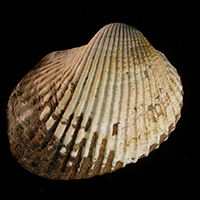|
< Previous family introduction |
|
|||||
 |
Family Arcidae Ark Shells
|
|||||
|
The Arcidae is a large, worldwide family of medium-sized to large shells, best known for the ark shells common on tropical mud and sand flats. There are more than 250 species in the family. They are filter feeders, remaining fixed and attached to the substrate by a byssus, a tuft of hair-like threads extruded by the foot. They are very diverse in habitat, both marine and estuarine, and from intertidal to abyssal depths. They are most common in the tropics, where species of Arca, Lamarcka and Barbatia are common inhabitants of coral reefs and sand flats. In NSW, the family is represented by only six species, two of which are so noticeable on the shore to make the family conspicuous. Barbatia pistachia is a southern Australian representative of Barbatia, common on rocky shores intertidally, while Anadara trapezia is a large, common species, restricted to eastern Australia. It lives on mud in estuaries, and is so plentiful that it is harvested for food. Identification Notes The Arcidae is characterised by a taxodont hinge consisting of a straight hinge line with many small interlocking teeth, and an external ligament. There is a thick periostracum, present to a greater or lesser extent depending on habitat, and worn away in beach-worn shells. Coverage All the species that occur in NSW are detailed here.
|